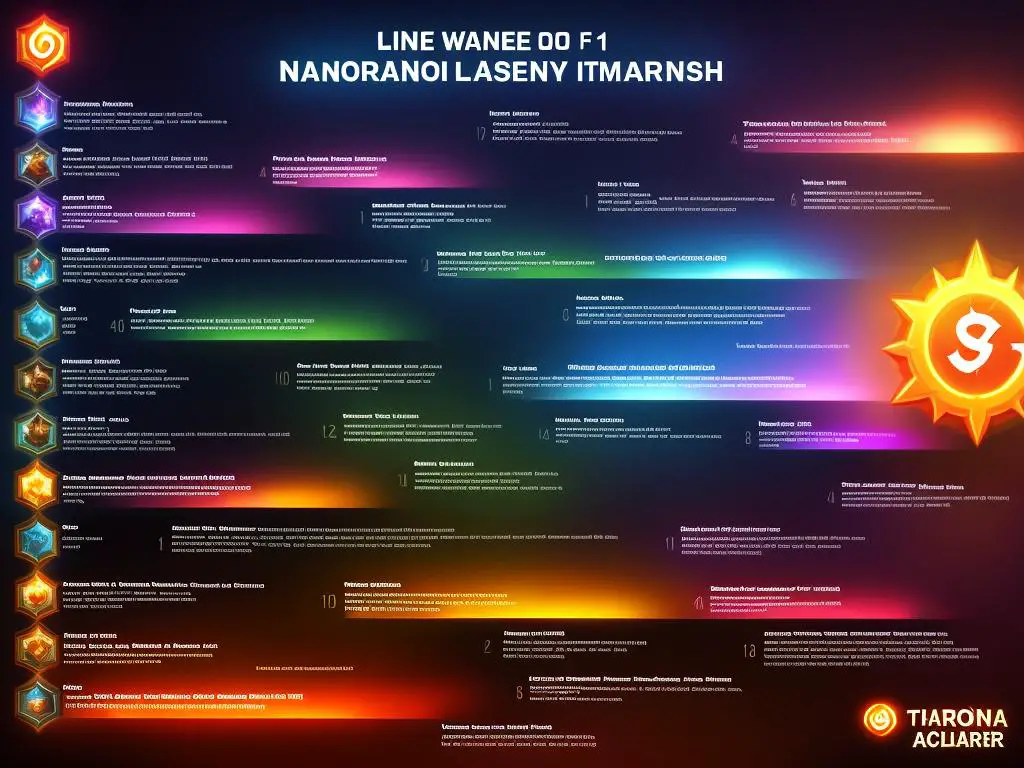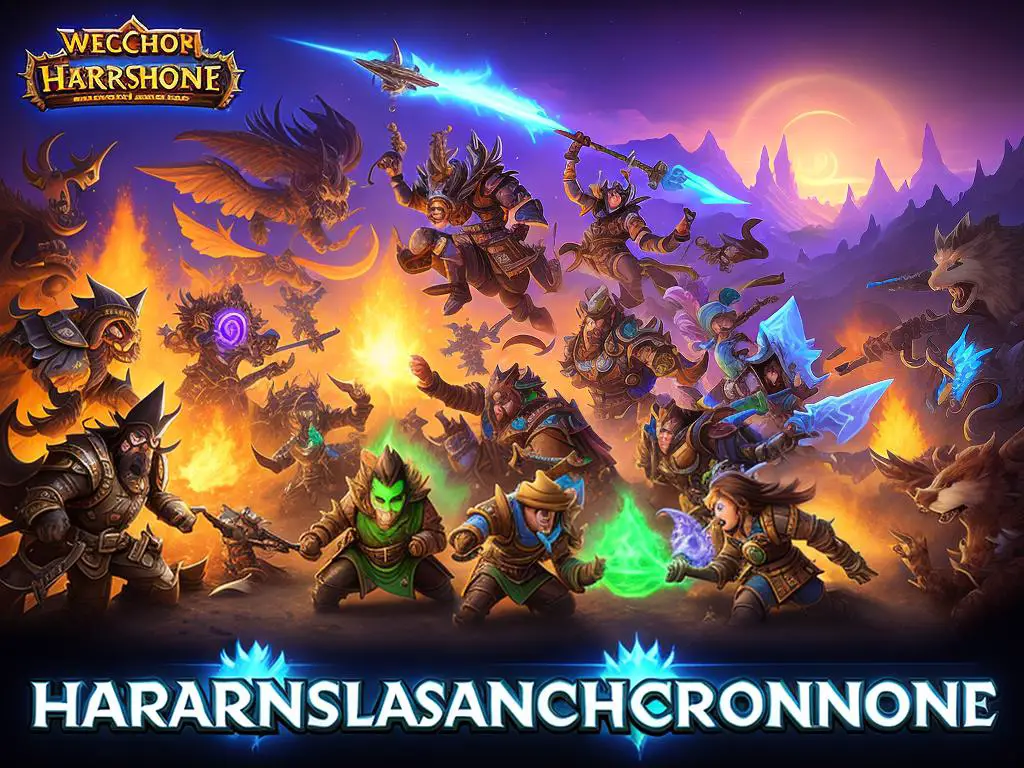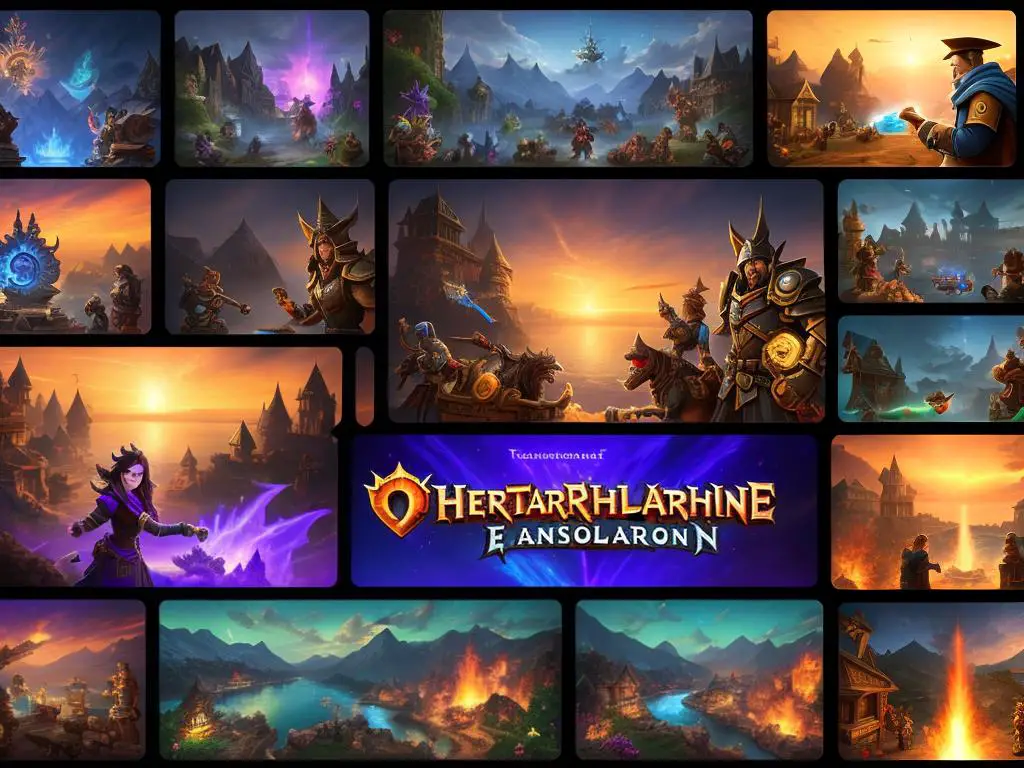In the realm of online strategy card games, Hearthstone stands as a pacesetter, combining Warcraft lore, tactical decision making, and a dash of luck into an engaging digital experience. Since its inception by Blizzard Entertainment in 2014, Hearthstone has launched numerous expansion packs, each adding a new dimension to the game and revolutionizing card play in its own unique way. The pivotal role of these expansions in the game’s progression is often underestimated by casual players. This piece aims to chart the timeline of Hearthstone expansions, delves deeper into the thematic inspirations that color them, and unpacks their strategic reverberations within the game. From grasping the intricacies of gameplay to tracing the impact of expansions on the Hearthstone community, a journey awaits through the captivating history of Hearthstone’s evolving universe.
Understanding Hearthstone: An Introduction
The Foundations of Hearthstone
Hearthstone is a free-to-play online digital collectible card game developed and published by Blizzard Entertainment. It sprang to life from the Warcraft series by using the same elements, characters, and relics. The official release arrived on March 11, 2014, but the beta version had already generated a significant interest among gamers globally in the preceding year.
Fundamentally, it is a card game where two opponents face off with decks consisting of 30 cards along with a chosen hero with a unique power. Players cast spells, use abilities, or summon characters in an attempt to exhaust the other player’s life total. Cards can be gained through game play or purchased with in-game gold or real world currency.
The Importance of Expansion Packs
In the world of Hearthstone, expansion packs hold a significant place. They serve a twofold purpose: to keep the game fresh and engaging and amplify the strategic depth of the game. Usually, with each expansion, Blizzard introduces new cards and mechanics to address game balance issues and promote diversity in deck building strategies.
An expansion is a significant event in Hearthstone not just because it increases the pool of available cards, but also due to the fact that it often marks a shift in the metagame (the game’s evolving competitive structure). Depending on the new cards and mechanics introduced, specific deck types may become more or less powerful, causing player strategies to adapt accordingly.
Launched initially, Hearthstone has grown significantly by introducing a myriad of expansions over time. “Curse of Naxxramas,” was the inaugural expansion introduced in July 2014, consisting of a single-player focused content expansion offering 30 new cards.
The year 2015 heralded the arrival of “Goblins vs. Gnomes,” complete with an impressive array of 123 new cards, which laid the foundation for future expansions to regularly inject more than 100 new cards. The same year, the trend persisted with the addition of “The Grand Tournament” and “Blackrock Mountain.”
Fast forward to 2016, the concept of yearly ‘rotations’ was introduced, where certain sets of cards became obsolete in the standard game mode. This started with “Whispers of the Old Gods” expansion in April 2016, followed by “One Night in Karazhan” and “Mean Streets of Gadgetzan.”
This pattern carried through all subsequent years, with each year showcasing a novel set of expansions and a fresh competitive gaming landscape in Hearthstone. Notably, in 2018, the game shifted gears from ‘Adventures’ to holistic ‘Expansions.’ Now, three full-size expansions are unveiled every year. This transition underlined the significance of these expansions in the game’s ongoing development and evolution.
Therefore, grasping the timeline of Hearthstone expansions is essential for understanding the progressively intricate and strategic aspects of the game. Each expansion represents a fresh chapter in Hearthstone’s narrative, offering both players and enthusiasts an opportunity to delve deeper into this captivating gaming universe.

Decoding the Expansions: Release Order
The maiden Hearthstone expansion, “Curse of Naxxramas,” was launched on July 22, 2014. This expansion draws inspiration from the Naxxramas raid found in World of Warcraft, thus also reflecting in the theme of the expansion.
Hearthstone Expansion 2: Goblins vs Gnomes
Coming up next, on December 8, 2014, Hearthstone released its second expansion, “Goblins vs Gnomes”. This expansion introduced a variety of mechanical minions inspired by the gnomish and goblin inventions in the World of Warcraft universe.
Hearthstone Expansion 3: The Grand Tournament
On August 24, 2015, the third expansion called “The Grand Tournament” was launched. Its theme was inspired by the Argent Tournament, a World of Warcraft in-game event.
Hearthstone Expansion 4: Whispers of the Old Gods
The fourth expansion, “Whispers of the Old Gods”, was released on April 26, 2016. This was the first time Hearthstone introduced Lovecraftian horror themes.
Hearthstone Expansion 5: One Night in Karazhan
“One Night in Karazhan,” was released on August 11, 2016. This expansion took the base of Karazhan from World of Warcraft and reimagined it as a magical party.
Hearthstone Expansion 6: Mean Streets of Gadgetzan
The sixth expansion was termed “Mean Streets of Gadgetzan”; launched on December 1, 2016. It is based off of the World of Warcraft city of Gadgetzan, an infamous hub for the darker elements of Azeroth.
Hearthstone Expansion 7: Journey to Un’Goro
The seventh expansion, launched on April 6, 2017, is known as “Journey to Un’Goro”. This expansion took players on a prehistoric journey filled with dinosaurs and primitive tribes.
Hearthstone Expansion 8: Knights of the Frozen Throne
“Knights of the Frozen Throne” was released on August 10, 2017. This expansion carried a theme inspired by the Frozen Throne storyline from World of Warcraft.
Hearthstone Expansion 9: Kobolds & Catacombs
Released on December 7, 2017, “Kobolds & Catacombs” is a riff on classic tabletop fantasy role-playing games, filled with monsters, loot, and dangerous bosses.
Further, Hearthstone continued to release various expansions with different themes like “The Witchwood,” “The Boomsday Project,” “Rastakhan’s Rumble,” “Rise of Shadows,” “Saviors of Uldum,” “Descent of Dragons,” “Ashes of Outland,” “Scholomance Academy,” “Madness at the Darkmoon Faire,” and the latest being “Forged in the Barrens” brought out on March 30, 2021.
Hearthstone expansions, deeply rooted in the World of Warcraft universe but also colourfully dabbed with broad fantasy themes and tropes, have played a pivotal role in the evolution of the game. Since its initial launch, Hearthstone has continually kept its players engaged and intrigued by strategically incorporating expansions that introduce fresh mechanics and expansive lore, making every battle a journey towards victory.

Exploring Individual Expansions: Key Features
Diving Deeper: The Role of Expansions in Hearthstone’s Transformation
Since coming on to the digital gaming scene in March 2014, Blizzard Entertainment’s Hearthstone has undergone significant evolution by the way of a stream of expansions. These expansions, each unique in their assortment of characters, card mechanics, and innovative concepts, have been instrumental in providing depth and variety to the gameplay. They’ve also collectively enhanced the original game’s complexity, making every battle a unique experience.
Rise of the Phoenix: Ashes of Outland (April 2020)
Bringing the Warcraft universe’s wasteland world to the forefront, Ashes of Outland introduced the first new class since Hearthstone’s launch: Demon Hunter. Equipped with powerful weapons and demonic minions, this class added a new dynamic to the game. The expansion also introduced Prime Cards – legendary minions with a powerful “Prime” version reshuffled into the player’s deck upon death.
Scholomance Revival: Scholomance Academy (August 2020)
Set in the haunted school of magic from the World of Warcraft lore, Scholomance Academy added a dual-class card system. Each class gained access to certain cards from one other class, resulting in unique combinations and diversified strategies. The keyword ability ‘Spellburst,’ which triggers a one-time effect when a spell is played, was also introduced.
Highlander Renaissance: Descent of Dragons (December 2019)
Centered around dragon-themed cards, this expansion added a new variety of powerful, high-cost dragon minions and spells. The ‘Invoke’ mechanic gave Galakrond, a hero card available in five variations, an increase in power. Additionally, ‘Sidequests,’ easier-to-complete versions of Quest cards, provided the opportunity to structure unique game strategies.
Old Gods Return: Whispers of the Old Gods (April 2016)
This expansion focused on the Lovecraftian horrors of Warcraft’s lore, with four Old Gods acting as legendary minions. Each Old God card had a game-changing ability that could shift the outcome of a match.
Introducing Standard and Wild: The Grand Tournament (August 2015)
The Grand Tournament brought in a new ranking system, dividing play into ‘Standard’ and ‘Wild’ formats. It also introduced the ‘Inspire’ mechanic, triggering effects based on the use of the player’s Hero Power and brought more focus to Hero Powers as a strategic component of gameplay.
Racing Against Time: Goblins vs Gnomes (December 2014)
Hearthstone’s first expansion, Goblins vs Gnomes, introduced ‘Mechs’, a new minion type with synergistic effects. The expansion also introduced ‘Spare Parts’ – low-cost, single-use spell cards gained through various means during a match.
Hearthstone’s various expansions have shaped the game’s evolution, each one introducing unique mechanics and thematic elements. These expansions have not only introduced new game classes but they have also diversified strategic options and revamped the ranking systems. These factors have kept Hearthstone consistently engaging and refreshing for players.

Strategic Impact: Significant Changes in Gameplay
A Deep Dive into Hearthstone Expansions: Exploring Shifting Strategies and Meta Evolution
Since its launch in 2014, Hearthstone has been kept alive and dynamic through a series of expansions. Ranging from the early days of Blackrock Mountain to the most recent Forged in the Barrens, each expansion has ushered in distinct challenges and strategies for the global player base.
Blackrock Mountain (April 2015)
The first memorable shift in meta was observed in Blackrock Mountain, the second expansion. The introduction of ‘Dragon’ as a tribal tag necessitated new interactions among cards and redefined deck buildings significantly. Dragon synergy powered decks became an uncharted territory waiting for players to explore and master, creating an exciting shift in gameplay strategy.
The Grand Tournament (August 2015)
The Grand Tournament posed the challenge of adaptability when it added the new Inspire mechanic to the game. Players had to now strategize their plays around hero powers which were, until then, mere secondary abilities. This expansion also rewarded the strategic employment of minions through effects like Joust and increased the game’s complexity with the introduction of over 100 new cards.
Whispers of the Old Gods (April 2016)
Whispers of the Old Gods, the third expansion, brought a thematic overhaul with Lovecraftian horror motifs that changed gameplay significantly. New ‘god’ cards like C’Thun, demanded dedicated deck-building strategies, causing a ripple effect in the meta and shifting player tactics.
Mean Streets of Gadgetzan (December 2016)
Mean Streets of Gadgetzan opened a new chapter in Hearthstone’s strategic evolution with the three crime families and their distinct abilities. The expansion added ‘tri-class’ cards, playable by three related classes, changing deck and combo building opportunities drastically.
Knights of the Frozen Throne (August 2017)
Arguably one of the most influential expansions, Knights of The Frozen Throne, added death knight hero cards. These cards provided new hero powers and affected the board state, which threw a wrench in many player’s strategies and prompted faster or more swingy turns than before.
Witchwood (April 2018)
Witchwood introduced two consequential keywords: echo and rush. Decks needed to balance these quick-impact cards with their larger game plan. The expansion also brought in a significant meta change with the most powerful card, “Shudderwock”, that forced players to build decks that could face the customized Shudderwock battlecry.
Rise of Shadows (April 2019)
Rise of Shadows, with its new abilities like lackeys and schemes, set the stage for an aggressive meta. The expansion demanded a balanced approach between quick victorious turns and resourceful, patient game plays.
Ashes of Outland (April 2020) and New Changes
Ashes of Outland brought a fresh set of strategies and meta changes by introducing a new class, the Demon Hunter. For the first time since launch, players had to construct strategies considering a completely new class with unique abilities.
The world of Hearthstone continually evolves with every new expansion, presenting players with intriguing meta shifts, novel character abilities, unexpected thematic elements, and innovative card abilities. These changes demand adaptability from players, challenging them to understand the changing dynamics and modify their strategies accordingly. It’s fair to say, the timeline of Hearthstone expansions offers a series of tactical puzzles necessary for mastering this intricate, yet captivating gameplay.

Community’s Perspective: Reception and Influence
The Dawn of the Expansions: Curse of Naxxramas
The inaugural Hearthstone expansion, Curse of Naxxramas launched in July 2014, set a robust framework for all expansions that came after. Applauded by the community, players reveled in the new thrill of the single-player adventure mode. However, it wasn’t without controversy – The in-game gold cost to unlock new wings was considered steep by many. This sparked heated debates around the cost-effectiveness of expansions, a dialogue that extended well beyond this first release.
Shaking the Meta: Goblins vs Gnomes
Goblins vs Gnomes, released in December 2014, introduced Hearthstone’s first new card type: Mechs. The expansion was met with mixed reactions. While players were excited about the new card type, they also voiced concerns about the excessive randomness or “RNG” introduced by some cards. This sparked discussions about the balance between skill and luck in Hearthstone, a conversation that influenced later expansions.
The Adventure Continues: Blackrock Mountain
The release of Blackrock Mountain in April 2015 met with overall positive community response. However, alongside the acclaimed single-player content, balance complaints arose over the dominant decks it spawned. Notably, the combination of Grim Patron, Warsong Commander, and Frothing Berserker led to a so-called “Patron Warrior” meta, prompting much debate about deck diversity.
Exploring Exciting New Territory: The Grand Tournament
The Grand Tournament, launched in August 2015, introduced a new mechanic, Inspire, but received a lukewarm response. The community felt the mechanic was underpowered, leading to less enthusiasm towards The Grand Tournament. Despite this, the expansion influenced future ones by demonstrating that Hearthstone can venture into totally new mechanics, even if not immediately successful.
Redefining the Meta: Whispers of the Old Gods
Whispers of the Old Gods, released in April 2016, was highly anticipated by the Hearthstone community. The community’s sentiment was overwhelmingly positive for introducing powerful, game-changing cards that redefined the meta. The reaction to the popular Old Gods cards influenced Blizzard’s approach to design and power level in future expansions.
A Formal Approach: Mean Streets of Gadgetzan
Mean Streets of Gadgetzan, released in December 2016, was significant because it introduced the concept of tri-class cards. Although initially exciting, the expansion later received criticism for creating overpowered combinations, most notably the “Pirate Warrior” deck. Despite the balance complaints, this expansion’s novel approach to class cards influenced later expansions, showing that Blizzard was willing to think outside the box to keep Hearthstone fresh and exciting.
In general, the community anticipates each Hearthstone expansion, sparking extensive discussion and debate. These conversations play a significant role in shaping the design and balance of subsequent expansions. While the community’s sentiment towards Hearthstone evolves, one thing doesn’t change: the fervor surrounding each new addition to the game.

The world of Hearthstone, with its myriad expansion packs, offers a rich tapestry of strategic evolution and dynamic gameplay. Through this exploration of the timeline of Hearthstone expansions, it is evident that each addition has not only expanded the card pool and diversified game strategies, but also stirred the global community in various ways. The constant flux and metamorphosis of Hearthstone signify its organic growth in tandem with its enthusiastic, global player base. As it continues to birth new expansions and shape gameplay in manifold ways, Hearthstone promises a future as enthralling as its storied past. It is a testament to Blizzard’s innovative spirit, constantly brewing compelling narratives and tactical elements within this digital card battleground.